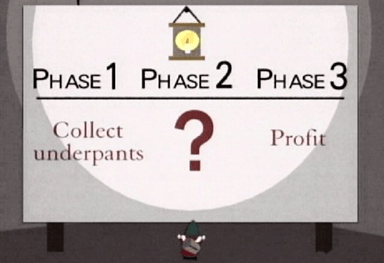Guest Post by Anna Staniszewski
We all know the magic formula for writing a children’s book series:

If, of course, you replace “collect underpants” with “come up with a million dollar idea for a kids’ book series.”
Well, maybe there’s a little more to it than that. Let’s look at that question mark part. (The profit part is a whole other guest post.) After you have your million dollar idea (and it’d better be one you LOVE because you’ll be working on it for a loooong time), it’s time to start writing and planning. Here are some things to consider.
Standalone or Standtogether?
You need to decide if your book can stand alone or if you’re going for the series right away. My first book, My Very UnFairy Tale Life, sold as a standalone with series potential. That meant the book came to a satisfying resolution but that there were a couple of threads that could be (and ultimately were) picked up in later books.
The benefit to writing a standalone with series potential is that a publisher sees you as a smaller risk. They don’t automatically have to buy three books from you; they can test out the first book, see how it does, and go from there.
Story and Character Arcs
Once you start writing the series, start looking for arcs everywhere. How will my character change and grow over the course of the first book, the second, the entire series? How can I give each book a satisfying beginning, middle, and end while also giving the series a satisfying shape? When you add up all of those individual story arcs, how will they push my character to grow? (e.g. In book 1, she’ll find her voice. In book 2, she’ll stop trying to control everything, etc.)
Of course, not all series work this way; some are episodic so that each book can stand alone. I think even in these types of series, though, you want to give your readers something more in each installment, something that will make the books feel like they’re building on each other. Even if those story and character arcs are small, they’ll make each follow-up book feel more satisfying.
The Domino Effect
So you sell your series and you start working with your editor. How do you deal with making changes to the first book, for example, when you know those changes will affect later books?
First, I recommend being open-minded. The series will evolve throughout the editing process and turn into something that you probably never imagined. This is a good thing! It means you’re being pushed to do your best work.
Second, remember that it should all go back to the story and character arcs we talked about. If you need to rethink something in book 3 because of changes in book 1, find a way to do it so that it gives your character even more to deal with. Try to see it as a challenge, not as a nuisance.
The End
How can you wrap up multiple books in a satisfying way? I think this is where those story and character arcs really come in. If you make sure you’ve resolved each of them then hopefully readers will like where things end up. It helps if you have an idea at the start of where you’d like your story to go, even if all you have is an image or a feeling. That way you have something to work toward, something that will guide you through each book.
I could go on and on about the ins and outs of writing a series, but the elements above are the ones that I get asked about the most. My final advice: It can be easy to lose steam as you’re working on a series. Even if you don’t love the story every step of the way, keep in mind why you were excited about it in the first place. If you’re excited, then chances are your readers will be too.
Related Posts:
Chapter Book Blueprints by Alison Potoma
How to Research KidLit at the AR Quiz Store by Marianne Knowles
 Born in Poland and raised in the United States, Anna Staniszewski grew up loving stories in both Polish and English. She was named the 2006-2007 Writer-in-Residence at the Boston Public Library and a winner of the 2009 PEN New England Susan P. Bloom Discovery Award. Currently, Anna lives outside of Boston with her husband and their black Labrador, Emma.
Born in Poland and raised in the United States, Anna Staniszewski grew up loving stories in both Polish and English. She was named the 2006-2007 Writer-in-Residence at the Boston Public Library and a winner of the 2009 PEN New England Susan P. Bloom Discovery Award. Currently, Anna lives outside of Boston with her husband and their black Labrador, Emma.
When she’s not writing, Anna spends her time teaching, reading, and challenging unicorns to games of hopscotch. She is the author of My Very UnFairy Tale Life and its sequels, My Epic Fairy Tale Fail and My Sort of Fairy Tale Ending, all published by Sourcebooks Jabberwocky. Look for the first book in Anna’s next tween series, The Dirt Diary, in January 2014, and visit her at www.annastan.com.

